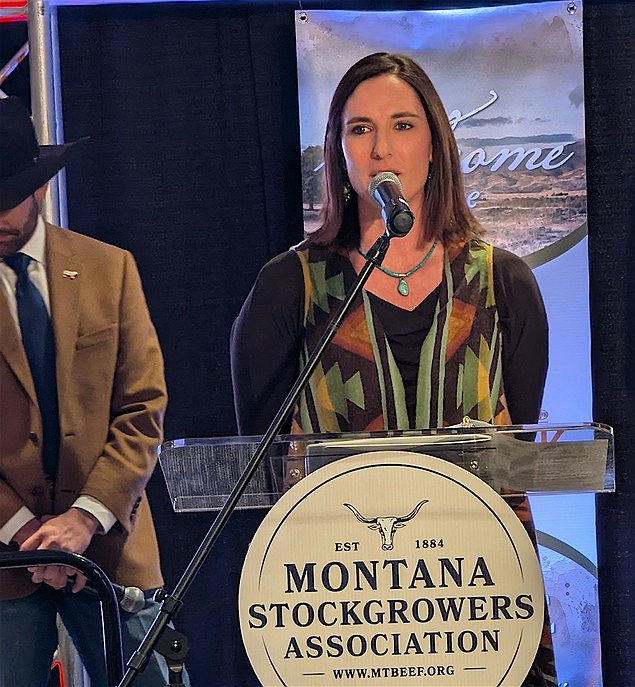Irvine Flats ranchers win state stewardship award
Irvine Flats west of Polson is cow country, with lots of grass, hills and swales. Ranch families are the main residents in the sparsely populated area, and one of those families, Greg and Lynn Gardner, their daughter Brittany and her husband Wacey Cathey, received the 2024 Montana Stockgrowers Association Stewardship Award.
The family business, G & G Livestock won the annual award that honors a Montana ranch that exemplifies environmental stewardship and demonstrates a commitment toward improved sustainability within the beef industry.
Greg and Lynn and Lynn’s parents, John and Betty Gordon, bought the ranch from Chuck and Penny Jarecki in 1990 “and we’ve been here ever since,” Greg said.
“Sustainability to me means that we have created a piece of land that not only can we profit from, but future generations can as well, and we leave it better than we found it,” Brittany explained in a video released on Instagram by the MSGA.
“Our main focus has been on spraying weeds and doing water slides to disperse the cattle better. We’ve put in maybe eight miles of pipeline, and then 1,000-gallon cement water tanks where we needed ‘em,” Greg said in the same video.
“It’s a great big honor,” he added. “It’s nice to be recognized for what we’re doing.”
Asked about their approach to range management, Greg said they use practices called rest rotation and deferred rest rotation. He learned a lot from his dad, who was a good range manager. Greg also earned a degree in range management.
“If you’ve got moisture in the spring, which we haven’t had for a couple of years, you can try to rest one or two pastures, just keep them idle for a year, which is rest rotation,” he said.
Alternatively, ranchers can graze a pasture in the spring one year, then graze it in the fall the following year, in a process called deferred rest rotation. The rest/rotations give plants time to relax and grow. But some plants do not need a vacation — noxious weeds.
“We spray weeds relentlessly,” Greg said. They also use biological controls such as a flea beetle to naturally control Dalmation toadflax.
“There are also bugs for leafy spurge,” he said. “There’s a good one for spotted knapweed too.”
But G & G Livestock’s biggest nemesis is sulphur cinquefoil.
“It’s a strawberry relative (members of the rosacea family),” Greg said. “It can crowd out spotted knapweed.”
Since spotted knapweed is tough to crowd out and the sulphur cinquefoil seeds stay in the ground for 10 to 15 years, they have to spray it because its biological control hasn’t been released to ranchers yet.
A new noxious invader is Ventenata, or wiregrass, which MSU Extension describes as a non-native winter annual grass. The newcomer has the potential to impact range, pasture, wild lands, and annual crops by decreasing agricultural production and increasing the risk of soil erosion.
Livestock won’t eat it, Greg said, since it has a sort of slick, silicon-tasting leaf. Also, chemicals to control it are three times more expensive to buy, not including the application cost.
Cathey Cattle Company: From ranch to table
All new things are not noxious though. A prime example is another part of this business born in 2019 when Brittany and Wacey started Cathey Cattle Company. It’s a direct-to-customer beef business.
The couple had been selling sides of beef to friends since 2011, but then there was a meat shortage.
"What really ramped me up to start CC," Brittany said was because a local grocery store couldn’t get ground beef.
“We saw that, and we were able to get them fresh ground beef in a short amount of time,” she said. The business has grown from there, fueled by customers “looking more and more not only for where their beef comes from but the story behind it.”
Brittany sends thank to Greg Hertz from Super 1 for continuing to carry their product.
She gets many questions about the beef business, including inquiries about country-of-origin labeling. In 2002, an older law from the 1940s was amended by Congress to require country-of-origin information, but then this was repealed for beef and pork in 2015. Of course Brittany thinks that beef labeling should be reinstated since they like knowing their beef grew up on local ranches.
The Catheys have their meat processed at White's Wholesale Meats in Ronan because White's is licensed by the United States Department of Agriculture. CCC received grants through the Department of Agriculture, which bought freezers for the business, and the grants require use of state or federally licensed processors.
Local beef, such as for their own use, goes to Montana Marbled Meats for processing.
With cattle also come vaccines.
“Personally, I think we (the cattle industry) over-vaccinate,” Greg said. Their ranch uses the feedlots’ protocol in order to send vigorous healthy calves to market.
One new technology that Greg is unsure of is virtual fencing. The premise is each cow is equipped with a neck chain or neck rope and a tag. There is no fence, but there are monitors which beep at cattle who venture too near the “fence line.”
If an adventurous cow tries to cross the perimeter line, she gets zapped, in the same way an electric fence would zap a critter. The approach is supposed to save money on fencing materials, labor and maintenance, but the rancher jury is still out on this.
Greg explains their approach to ranch work: “We use four-wheelers and horses. We have a hired man who has a good cow dog, and that’s a big help. Our hired man night calves for Wacey and Brittany, and his daughter night calves for Lynn and me.”
“If I could just figure out a way to run a ranch without bulls,” he said, having just hauled a bull with a broken hip to Montana Marbled Meats. “They’re so hard on everything and on themselves.”



